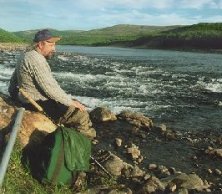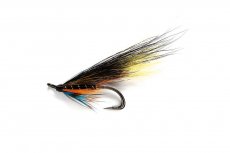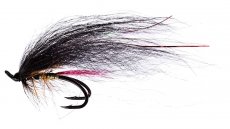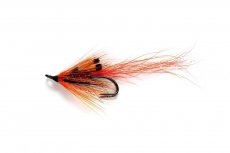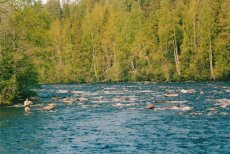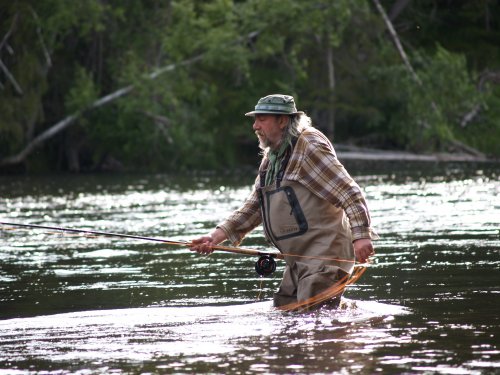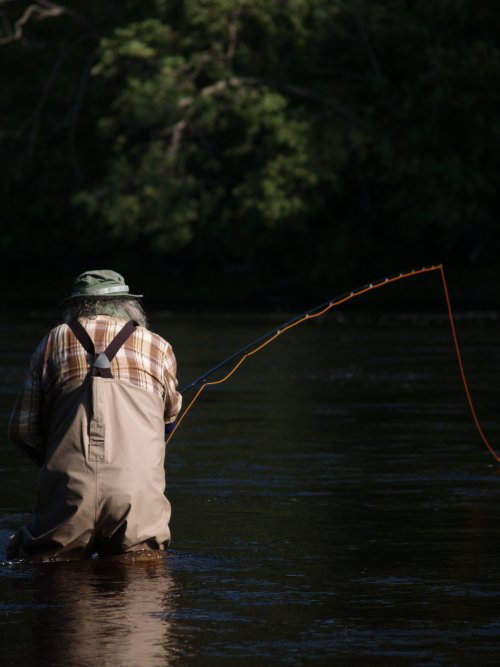Summary of most important salmon rivers in Sweden.
I live in northern Sweden near the polar circle, and my primary hobby is fishing. I spend about 80% of my time fly fishing, while in the fall I jig for fish for perch and pike and fish spinners in the sea off Norway for cod and other salt-water fish.
Of my 80% fly fishing, I concentrate about 80% of my time on salmon. I live close to the excellent salmon river Byskealv ("Byske River"), and must say that the disease Salmon Salaris is untreatable. I have fished for salmon in Norway, Russia, Canada, Scotland and Ireland - all Atlantic rather than Pacific salmon.
About 15-20 years ago, the salmon situation in Sweden looked quite poor - many were caught with nets directly from the ocean or at the mouths of rivers. Only a few rivers in southern Sweden were of note, mainly the Morrum and Em rivers. With the decline of employment opportunities in the northern part of the country (due to technological improvements in mining and forestry), focus turned to tourism and sport fishing. Salmon fishing was banned or severely limited, with results evident after just a few years.
There are now about 60 rivers in Sweden where salmon migrate. There are reservoirs on some of these, and salmon are artificially stocked (Gotaalv, Lagan, Indalsalv, Dalalv, Ljungan, Skelleftealv, Lulealv), while others are so-called national rivers. On these, dams are not permitted, and salmon can migrate naturally (Morrum, Em, Lodge, Byske, Kage, Pitealv, Ranealv, Torne, and Kalixalv). In some rivers, salmon only migrate a few kilometers, in others tens to hundreds. The longest is the Torne, with the tributaries Tarando, Muonio, and Lainio, reaching over 550 km. Some rivers are quite large and are mostly fished from harling boats (Indals, Skellefte, Lulealv, lower stretches of the Pitealv, Kalix and Torne), while others are wonderful fly fishing rivers (Morrum, Em, Byske, Logde, Angesan), and some small streams that can be fished with one-handed rods (Ore, Rickle, Kage). There are two salmon species in Sweden - true Atlantic salmon on the west coast from Goteborg to Lagan, and a Baltic form of salmon in rivers leading to the Baltic Sea. This Baltic form is bigger with a significantly higher average weight, so most of the largest salmon in the world are likely caught in Sweden. Only a couple of Norse rivers can compare, such as the Alta, Namsen, Tana and Aroy, as well as some Russian - the Varzina and the tributary Dviny. The first salmon appear in rivers in southern Sweden in April and continue throughout summer until September. In northern Sweden the timing is from the end of May to the end of August.
Before turning to specific rivers, however, I would like to point out the difference between forest and mountain rivers. Forest rivers have their headwaters in forests, and the highest spring water levels are from April to the beginning of May. Mountain rivers are much longer, with headwaters in the mountains along the border with Norway, and have two high-water peaks - in April to the beginning of May, and in summer at end of June to beginning of July, when snow melts in the mountains.
The most river going from north to south is the Torne, creating the border between Sweden and Finland. It is a huge river, estimated to have 550 km of salmon waters including its tributaries. The lower sections are mostly fished from harling boats - Kukkolla, Matkakkoski, Vuento, Kattilakkoski, Antis, Kengis. In the Torne itself, salmon are present just to the confluence of the Tarendo - why they don't migrate further is not yet known. There are no obstructions, but the upper Torne is geologically young - just a few thousand years old. An experiment is underway to stock salmon to the upper stretches, and if successful they will lengthen the salmon waters in Torne and Vittangi by another 150-200 km. The tributary Muonio - Konkame and especially the Lanio are perfect for fishing, and the Lanio in particular is a truly wild river. License prices are reasonable (as in all Swedish rivers) - 200 SKR/week. The river is known for its large salmon, with one record of a 40 kg fish from 1942, unfortunately not photographed. Every year, 20-25 kg fish are caught. In summer, grilse of around 3 kg become common. About 3000-10,000 fish are caught yearly, which is typical for a mountain river.
Next is the river Kalix, another large river. Salmon used to not be able to get past the Jockfall waterfall, but today there's a great ladder allowing them to continue to the upper reach and the Kaitum tributary, where they can swim up to the Killinge waterfall. In the lower stretch are the Angesan and Lina tributaries, about 100 km of perfect salmon waters for fly fishing. The catch is around 100 - 5000 per year including the tributaries; in Angesan itself about 600 salmon in a good year. Kalix is a mountain river, though the Angesan tributary is a forest river type.
The Ranealv is a forest river. There aren't too many salmon, so it certainly doesn't make sense to plan a trip just to this river. The number of salmon is rising, although slowly. There are a number of lakes in the lower parts with large pike, so probably many young salmon don't make it back to the ocean. The lower kilometers are excellent grayling waters, with even sea grayling migrating there. The upper sections are also celebrated for grayling.
On the Lulealv, there are salmon in just the first 30 km, above which they are blocked by a reservoir. There are many and quite large fish caught in the lower section, though from harling boats.
On the forest river Pitealv, salmon are blocked about 50 km upstream by the largest waterfall in Europe, Storforsen. For salmon fishing, this river isn't very interesting. The lower section meanders and there are no rapids. It is from 150-300 m wide, and is fished mainly from harling boats - not so much for salmon, of which there are few, but rather for sea trout.
The Abyalv is a smaller forest river, with many salmon and mainly sea trout. It can easily be waded, but needs enough summer rains to be at its best. About 60 km from the ocean is a large weir, but with a well-functioning fish ladder. The largest salmon caught here was 19.7 kg, in 1996.
The next river is the Byskealv, but I'll leave till last since it is my home water and I'm a member of the fishing club there.
The Kagealv is a small forest river, with salmon up to 35-40 km, of which about 20 km runs through agricultural land and the rest through natural areas. Salmon were eliminated here at the beginning of the 19th century, when the river contained many weirs and factories supporting forestry. The factories have disappeared and weirs taken out by spring floods, and for the past 15-17 years the very active local fishing club led by the real sportsman Svante Janson has started to intensively stock salmon. Today, the river produces between 30-300 salmon per year, and has a bright future. Electrofishing has shown that this river has the largest number of small salmon per square meter in Sweden. The license costs are also interesting - 300 SKR per year, or 50 SKR a week. I haven't yet come across more reasonable prices. Salmon weights here range from 2-10 kg.
The last river coming down from the north is the Skelleftealv, very similar to the Lulealv. There is a reservoir 35 km from the sea, but around 1000 salmon and sea trout are caught here every year, mostly from harling boats but also from the banks with heavy spinners. Every year, salmon weighing about 20 kg are caught.
My home waters are the river Byskealv, a forest river often called the Morrum of the north. Its medium sized, has many rapids, and is a perfect place to fly fish for salmon. Waders are necessary, though wading is difficult and I manage to "take a swim" a few times a year. The bottom is gravel mixed with huge boulders and holes, and since in the past the river was used to float trees, there are occasional logs on the bottom that are extremely slick. Fish used to have difficulty getting past the Fallforts waterfall 35 km from the sea, but the local club installed two fish ladders, a small one on the south side and in the year 2000 a larger on the north. Both work well, and from the middle of June salmon can be found in the upper reaches. The northern ladder also has an aquarium where you can watch fish. It's quite a psychological shock - I almost got a stroke when a sea trout weighing around 8 kg and a salmon weighing 15-20 kg swam within 2 meters of me! Only for those with strong nerves!
No one knows how far salmon go upstream - the river starts in the Arvidsjaur Lake about 120 km from the sea. Four smaller rivers flow into this lake, and I fish for grayling and pike in one of them. Three years ago a Laplander showed me a large trout that he caught there - though it wasn't a trout but a male salmon, around 3-4 kg. The river is not for beginners, though, since it is mostly in the wild, with forest right up to the banks, making casting technique critical. Being able to handle a two-handed fly rod (14-16 feet) with special casts such as the single and double Spey or underhand is absolutely necessary. The first salmon arrive at the end of May, and until the end of June large fish can be found - the largest salmon caught here weighed 22 kg, in 1999. The beginning of July marks a quiet period, though from mid-July through August the smaller 1.5-3 kg grilse arrive, last year in huge numbers.
The season officially begins June 19th, but no one pays attention to it, even the fishing club, though of course until the official beginning it is only catch-and-release. This can also be psychologically challenging - 2 years ago I had to release an approximately 15 kg salmon, and last year one around 13 kg. My largest salmon from the Byske was in 1996 and weighed 14.5 kg, taken at the beginning of August in Landfors. The beginning of the season is currently changed. Since 2002, the opening date was cancelled and fishing can be done from the ice-break (April) till the end of August.







